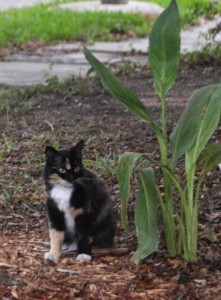Originally published
by Cheshire Kitten on 25 October 2010
in the Animal Rescue section of The Anipal Times

The United States just celebrated the 10th National Feral Cat Day on 16 October 2010. Alley Cat Allies, a group of humans who advocate for cats, started this event as part of an education campaign to increase awareness for appropriate care of feral cats. ACA education and advocacy aims to protect the interests of all domestic cats and to reduce the number of cats killed in pounds and shelters every year. Since ACA’s founding, humans have started more than 250 local non-profits to help feral cats.
Feral Cat Advocacy and Education
You might wonder why feral cats need an advocacy organization. Well, not all humans are excited to see cats in the garden. The Washington Post recently published a story in the gardening section that touched on conflict between cats and bird advocates. The bird people say that cats outdoors are killing large numbers of migratory birds. The Alley Cat Allies spokeswoman, however, says that humans kill many more birds with cars, etc., than feral cats do, but she agrees with bird advocates that companion cats should be kept inside or closely supervised while outdoors. The article also mentions bibs for cats, a recent invention that interferes just enough with cats’ coordination and timing to make it hard for us to catch birds but not enough to keep us from jumping around and having a grand time outside.
The first thing humans need to learn to make effective policies for cats is the difference between stray cats and ferals. Stray cats are socialized to humans and will converse with them or be friendly while ferals are unaccustomed to human contact and are very wary. Stray cats can be adopted into homes and thrive, whereas ferals are too uncomfortable to live inside. Alley Cat Allies advocates trap, neuter and release (TNR) and a return to life in their colonies for ferals.
The second thing they need to understand is how fast cats can reproduce if they aren’t spayed or neutered. Animal control policies that rely on rounding up homeless cats and euthanizing them don’t really work to control cat population because more cats are always coming. Research shows that TNR reduces cat populations over time.
National Feral Cat Day Celebrations
Some communities celebrate National Feral Cat Day by organizing spay/neuter clinics for feral cats. Volunteers at the veterinary school at the University of Tennessee in Knoxville performed operations on 108 feral cats, WBIR reported. Feral cats even got attention in the nation’s capital. NBC Washington reported on CatNIPP, a Washington Humane Society TNR program. In addition to the National Feral Cat Day initiative, this group traps, neuters and releases 70 or 80 cats every month.
Other communities celebrate by improving life for ferals by updating habitat or improving ferals’ relationship with humans. WNDU reported that volunteers of the Michiana Feral Cat Initiative in Mishawaka, Indiana, built shelters out of Styrofoam to help keep ferals warm in the winter. A community in New York made 16 October a special day to adopt semi-feral, or barn cats, the Hudson Valley Press reported. In California, the group Catalyst for Cats celebrated by reminding other humans the service feral cats perform by controlling the rodent population, the Santa Maria Times reported. According to the article, cats provide a much “greener” rodent removal than placing poison in the yard.
More than 200 communities celebrated National Feral Cat Day celebrations this year, Elizabeth Parowski of ACA said. In addition to events, several cities, including Baltimore, Washington and Chicago, have officially adopted a TNR policy for feral cats.
“There is a national shift taking place, where cities and communities are looking for humane ways to care for stray and feral cats—and not resort to killing healthy animals. And we’re here to help,” Parowski said. ACA sells gear that can make for great openers for conversations about TNR.
On a personal note, Mack, one of our garden kitties, is at the vet for his neutering operation as I finish this story. So far this year, my humans have taken in six. At the moment, we have one more to go, a little black girl we call Twinkle.